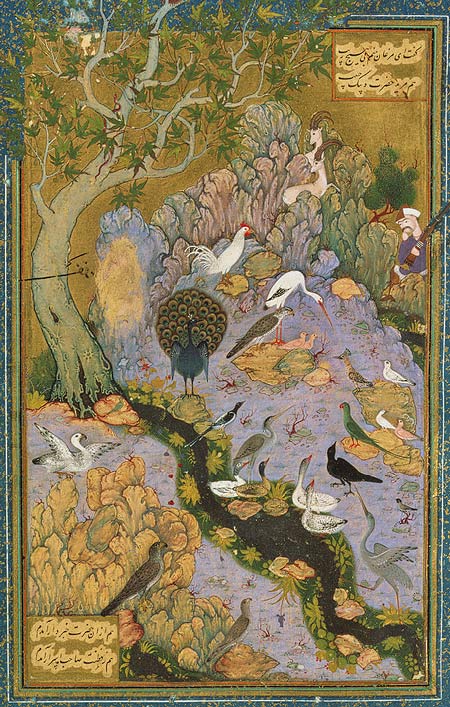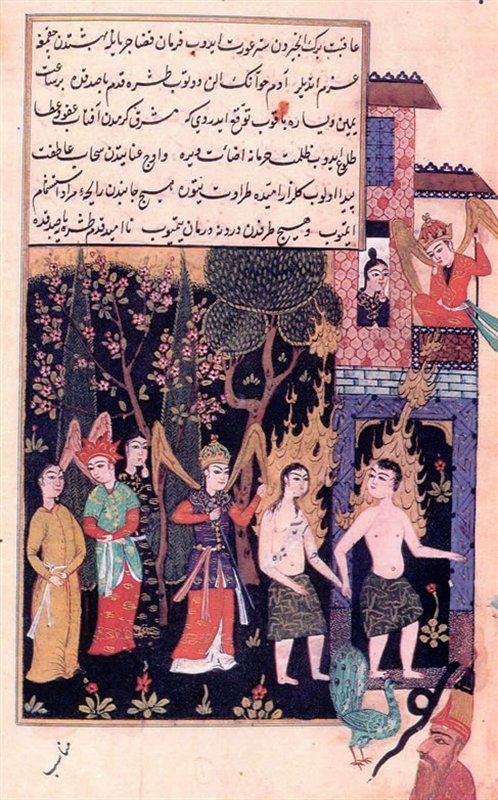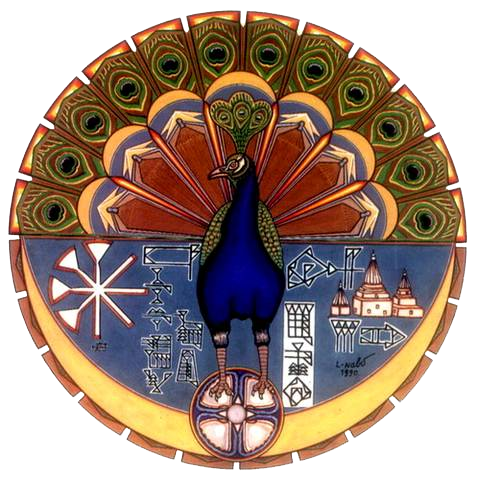5. The legendary bestiaries in the Islamic cultures
Animals have an important place in Islamic cultures: they are mentioned in the founding texts, they accompany the temptation of Adam and Eve, or the prophet Solomon. A moral allegory as in Christianity, they represent evil, or they express moral or spiritual aspirations. Drawn from the vast repertory of decorative arts in Islam, animals are also found in tales and poetry. Finally, the legality animals in food has been debated at great length by Muslim jurists and remains an important issue in the affirmation of Muslim identity.
The rich bestiaries/collections of mythical animals in Islamic culture were developed by drawing elements from history and ancient myths, and from the near-eastern/middle-eastern monotheistic traditions. The peacock is an excellent example.
The hoope instructing the birds
The peacock is a decorative motif that is very common in Islamic art: it can be found embroidered with shimmering colours on precious fabrics, etched on bronze or silver water pitchers, or painted on Ottoman ceramic dishes. The imaginary animal Buraq, the Prophet’s legendary riding horse during his night journey to Jerusalem, is depicted with a peacock’s tail. In the Persian miniature illustrating The Conference of the Birds, the artist Habib-All Savadji Rifah, who was a contemporary to the powerful Safavid dynasty, painted in the centre-right part of the image a small hoopoe addressing the group of birds in the middle with the peacock spreading out its feathered wings. A goat on the mountain and a figure, both without any relation to the story, are contemplating the scene.

Persian illustration from The Conference of the Birds by Habib-Allah Savadji (approximately 1600).
Wikimedia Commons. Usable under the conditions of the GNU Free Documentation License:
Public domain
Image under URL: http://commons.wikimedia.org/wiki/File:Conference_of_the_birds.jpg
The peacock in The Conference of the Birds
Then the peacock came, with a golden dress and feathers of one hundred, what am I saying? one hundred thousand colours. He exhibits himself in all his beauty, like a new bride; each of his feathers manifests his glory. The painter of the invisible world, he said, gave from his own hand his brush to djinns to create him. [The peacock said:] “Although I am Gabriel among birds, something far from good came upon me through fate. Somewhere a foul serpent became my companion, so I fell in humiliation from the earthy paradise. When the place of my solitary worship was changed, my legs were tied up to the place where I stood. Yet I am resolved, with the help of a guide, to find my way to heaven from this dark place. I am not the kind of man to reach the king. To be moving about would be enough for me. Why should the Sīmurgh care about me at all? The highest paradise is enough for me. I have no other things to do in this world, if only I can get to Heaven once more.” The hoopoe replied: "O you who voluntarily leave the true path! Do know that the one who desires the palace of this king, much better than the palace you mention, has nothing better to do than to come close to it. This is the home of the soul, this is eternity, the object of our desires, the home of the heart, in one word the seat of the truth. The Highest is this vast ocean, and the paradise of earthly delights is only a small drop of it. Who possesses the ocean possesses the drop, and everything that is not this ocean is madness. When you can possess the ocean, why would you only seek a drop of dew at night? Can the one who shares the secrets of the sun only look at an atom of dust? Can the one who has everything only be happy with part of it? Does the soul need the members of the body? If you are a perfect man, see the whole, search the whole, be the whole, choose the whole.
The peacock in The Conference of the Birds by Farid al-Din 'Attār (12th century). Trans. Marie Lebert.
The famous book by the 'Attar mystic (twelfth/thirteenth century) Mantiq al tayr (The Conference of the Birds) is a story of initiation, teaching the path toward the perfect worship of God. The title of the poem is inspired by the Quran (27, 16), which attributes to king-prophet Solomon the understanding of the language of birds. The theme of the birds’ journey is not new: it is inspired in particular by a mystical story attributed to the Persian scholar al-Ghazzali (eleventh century). In The Conference of the Birds, a flock of thousands of birds, led by the hoopoe, want to choose a king for themselves but the hoopoe discourages them because they already have the Simorgh as their rightful king. Each bird has a specific character, with the peacock symbolizing the "lost souls" misplaced by Satan. Frightened by the tests announced by the hoopoe, most of the birds give up. To reach the Simorgh bird-king, the birds must cross seven valleys symbolizing the steps toward God. Only thirty birds survive. In the end, after they are accepted by the bird-king, they see themselves reflected in the Simorgh and they lose themselves in him "to the end and for ever".
The expulsion of Adam and Eve from the garden

Miniature
National Library Jerusalem Yah. Ms. Ar.115
Image under URL: http://www.tali-virtualmidrash.org.il/ArtEng.aspx?art=410
(19/12/2014)
The serpent according to Al-Tabari
It is reported that in paradise there was nothing more beautiful than the serpent, except Adam. But Iblīs went to find the serpent, and told him: I will give you some advice so I want to talk with you. Make me secretly enter the paradise (...). The snake opened his mouth for Iblīs to enter and be in the presence of Adam.
Al-Tabarī, The History of the Prophets and Kings, chapter XXVII. Trans. Marie Lebert
In religious terms, the peacock can become a symbol of disgrace or bad behaviour. Arrogant, as Iblis who refused to bow before Adam, the peacock is theologically disgraced because of its arrogance spreading out its feathered wings. According to a popular myth, the peacock associated itself with Iblis who stood in front of the door of Paradise and tried to enter by any means [see module Islam II, page 3). Seeing the peacock eating snakes, he was transformed into a snake. Swallowed by the peacock, he entered the magical garden of Jannah where Adam and Hawwa (Eve) were staying. He did not suffer from thirst, nor from his nakedness or hunger. The couple could eat fruit (2, 33 and 7, 18) with the exception of a tree (19- 24), but was tempted by the devil (2, 30-37, 19-21). A satanic whisper made them hope for eternity, power and an angelic nature. The devil showed them "the tree of immortality and an everlasting kingdom” (20, 118). He seduced them (7, 21), he "and made them slip" (2, 43). Having eaten the fruit, they saw their nakedness and they had to "sew garments with the leaves of paradise" (20, 119). The forbibben couple was reduced "to the lowest level" and descended on earth (7, 23) for a while (2, 34). God sent them towards the right path. After the fall, Adam landed in Arabia, in the arid and stony valley of 'Arafa. This is where Eve found and "recognized" him. It is in the company of the peacock, that Adam and Eve succumbed to the temptation and were expelled from the divine garden. Al-Muqqadasi (Arab geographer from the tenth century) pities the peacock, as the victim of the devil’s slyness: « Quand il regarde ses plumes, il se souvient du paradis et quand il regarde ses pieds, il se souvient de sa faute.»
The peacock in yazidism

Public domain
http://www.cais-soas.com/CAIS/virtual_museum/image_library.htm
Image under URL: http://www.cais-soas.com/CAIS/Images2/Misc/Yazidi_symbol.gif
.
The peacock is the revered bird of Yazidism. Its followers are dispersed in small communities in Syria, Turkey, Armenia and Iran. Most live in Iraqi Kurdistan. Many have recently migrated to Germany. The monotheism of this movement was established between the twelfth and fifteenth centuries. Massignon describes this movement as a Sunni and anti-Shi'ite sect that is "specific to Kurdish Islam". The origin of their name is greatly debated and their religion is not well known. An infinitely good God entrusted men to the seven angels (melek). After descending on Earth, they gave/made laws[?] and helped men, and then they went back to the heavens leaving among them several sheikhs. The most important angel, the first divine creature, is the beautiful peacock whose shimmering tail glitters a thousand lights. During their great annual celebration, the Yazidis take around the holy images of the seven sindjaqs showing a peacock.






